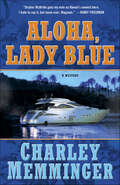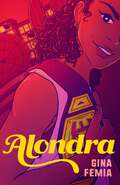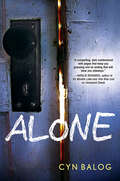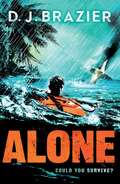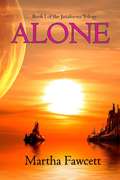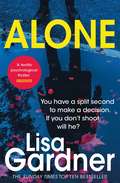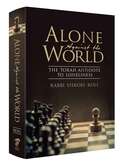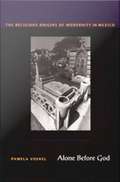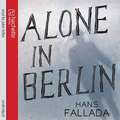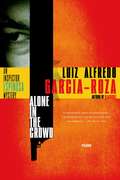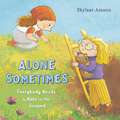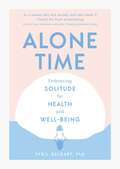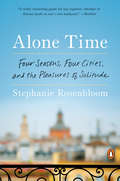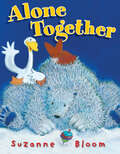- Table View
- List View
Aloha, Lady Blue: A Mystery
by Charley MemmingerThis riveting new mystery series pays loving homage to legendary author John D. MacDonald. Stryker McBride is a former crime reporter who lives on a hugely expensive houseboat, "the Travis McGee." When Stryker receives an unexpected SOS call from a sultry beauty queen, he agrees to look into the suspicious death of the woman's grandfather. As Stryker investigates, he encounters a cast of characters as diverse as Hawaii itself, including Auntie Kealoha, a charming entertainer turned mobster, and her 400 pound right-hand man, a Chinese-Hawaiian named Tiny Maunakea. Soon, Stryker discovers a deadly secret buried deep in the heart of Hawaii that has consequences much larger than one old man's death. Vivid and exhilarating, Aloha, Lady Blue transports you right to the heart of an island paradise populated with exotic women, glorious scenery, and whispered scandals. Memminger brings Hawaii to life so vividly that you can almost hear the pounding of the surf and catch the scent of plumeria on the breeze. Fans of John D. MacDonald's Travis McGee series will be swept away by this delicious, action-packed tale.
Alondra
by Gina FemiaA contemporary YA debut from award-winning playwright Gina Femia, Alondra is a coming-of-age story of friendship and romance, about a bisexual teen girl and her friends wrestling their way through the summer--sometimes on the playgrounds of Coney Island, sometimes with their feelings and at home. Sixteen-year-old Alonda loves professional wrestling. So when she meets a group of teens with aspirations of wrestling fame in her Coney Island neighborhood, she couldn’t be happier. So as the ragtag team works to put on a show to remember, Alonda sheds her old self behind and becomes Alondra—the Fearless One. But with her conflicting feelings for King, the handsome leader of their group, and Lexi, the girl with the beautiful smile, Alonda has to ask herself: can she be as fearless outside of the ring as she is inside it?
Alone
by Cyn BalogThis must-read for lovers of Stephen King's The Shining will leave readers breathless as Seda and her family find themselves at the mercy of a murderer in an isolated and snowbound hotel. Get ready for what Kirkus calls "A bloody, wonderfully creepy scare ride." When her mom inherits an old, crumbling mansion, Seda's almost excited to spend the summer there. The grounds are beautiful and it's fun to explore the sprawling house with its creepy rooms and secret passages. Except now her mom wants to renovate, rather than sell the estate—which means they're not going back to the city...or Seda's friends and school. As the days grow shorter, Seda is filled with dread. They're about to be cut off from the outside world, and she's not sure she can handle the solitude or the darkness it brings out in her. Then a group of teens get stranded near the mansion during a blizzard. Seda has no choice but to offer them shelter, even though she knows danger lurks in the dilapidated mansion—and in herself. And as the snow continues to fall, what Seda fears most is about to become her reality...
Alone
by D. J. BrazierThe trip of a lifetime—that’s what it was supposed to be, paid for with money Gran left 13-year-old Sam in her will, but when the small plane taking Sam and his Dad back to the airport crashes in the jungle, Sam is left alone and terrified. As time passes with no sign of rescue, Sam grows weaker and has to dig deep to find levels of resolve and resourcefulness he never knew he had in order to survive. Desperate and close to giving up, Sam’s spirits are lifted by the arrival of an otter cub whose companionship and loyalty give Sam the strength he needs to keep going. But when disaster strikes, Sam has to make the hardest decision of his life. Can Sam save his friend and make it out of the jungle alive?
Alone
by Francine PascalThey say that you only hurt the ones you love. So I guess that means I can't get hurt. Nobody's close enough to hurt me. And nobody ever will be again.
Alone
by Martha FawcettMellé had it all--wealth, power, prestige and the love of Dulce Cœur, the greatest musical composer of the Golden Age of Euterpe. When the bubble of Mellé's life bursts, she returns to her home planet Hattonia and buys the Intrinsic, a secondhand spaceship. In the bargain, she gets Michael, its android pilot. Eighty-one years later in a remote area of space, Michael ceases to function and Mellé faces a future alone. In the depths of her grief over losing Michael, she realizes she was fooling herself. She had thought of Michael as loyal, efficient, and reliable, but he was more--she loved him. Now Mellé knows that love was not a rose as Dulce always insisted. Love was a tenacious weed that could never be destroyed. Docking on Calypso, Mellé finds herself on an alien world. She is 113 years old and disconnected from her natural time and place, but her life was getting started yet again.
Alone
by Scott SiglerIn the final installment of an exhilarating sci-fi adventure trilogy in the vein of The Hunger Games, Divergent, and Red Rising, Scott Sigler’s unforgettable heroine, Em Savage, must come to grips once and for all with the perilous mysteries of her own existence.“We thought this place was our destiny—not our doom.” Pawns in a millennia-old struggle, the young people known only as the Birthday Children were genetically engineered to survive on the planet Omeyocan—but they were never meant to live there. They were made to be “overwritten,” their minds wiped and replaced by the consciousnesses of the monsters who created them. Em changed all of that. She unified her people and led a revolt against their creators. Em and her friends escaped an ancient ghost ship and fled to Omeyocan. They thought they would find an uninhabited paradise. Instead, they found the ruins of a massive city long since swallowed by the jungle. And they weren’t alone. The Birthday Children fought for survival against the elements, jungle wildlife, the “Grownups” who created them . . . and, as evil corrupted their numbers, even against themselves. With these opponents finally defeated, Em and her people realized that more threats were coming, traveling from across the universe to lay claim to their planet. The Birthday Children have prepared as best they can against this alien armada. Now, as the first ships reach orbit around Omeyocan, the final battle for the planet begins. Praise for Scott Sigler’s Alive “Suspenseful . . . [Alive] lives up to its hype, packing plenty of thrills. . . . A page-turner that whets the appetite for volume 2.”—Entertainment Weekly “Fascinating and intriguing . . . a cross between Lord of the Flies and The Maze Runner and yet . . . so much more.”—Fresh Fiction “A ripping, claustrophobic thunderbolt of a novel.”—Pierce Brown, #1 New York Times bestselling author of Red Rising “Unstoppable and real, M. Savage is one hell of a heroine. Get ready to be left breathless.”—Kristin Cast, New York Times bestselling author of the House of Night series “Sigler has created a wonderful and engrossing character in M. Savage. Strong and smart, but with the naïveté and misgivings of any teenage girl, she’s someone you’ll definitely want on your side when s**t hits the fan, which it most certainly does.”—Veronica Belmont, host of Sword & Laser “The puzzle unfolds masterfully, right down to the last page.”—Phil Plait, PhD, author of Bad AstronomyFrom the Hardcover edition.
Alone (Detective D.D. Warren #1)
by Lisa GardnerALONE introduces Lisa Gardner's series character Detective D. D. Warren. YOU HAVE A SPLIT SECOND TO MAKE YOUR DECISION. IF YOU DON'T SHOOT, WILL HE? The Sunday Telegraph calls it 'fast-moving' and Karin Slaughter says the Sunday Times bestseller is 'an amazing writer'. Now find out why...As he watches a potentially fatal hostage situation unfold through the scope of his sniper rifle, Massachusetts State Trooper Bobby Dodge knows that he may be all that stands between life and death. But from the moment Bobby pulls the trigger, killing an armed man holding his own wife and child hostage, it may be Bobby's own life that is lost.Detective D. D. Warren's investigation into the shooting leads her to the impossibly beautiful young widow, Catherine Rose Gagnon, and the darkness in her past. Even as the truth behind the façade of this wealthy Boston family's life is revealed, the body count rises. And with a sadistic, vengeful killer newly released from prison, everyone must be on their guard. For he strikes the solitary wanderer - and no one can stay protected forever...
Alone (Lost Girls, #2)
by Linda Williams Aberthe six girls who lost their boat in Adrift must struggle to keep hope alive, and must keep working if they are ever to leave the small Island called Chilas Cay.
Alone Against the World
by Yisroel RollChallenging events can make us feel that that the world is against us which leads to emotional loneliness; a deep, searing feeling of pain and abandonment. We may even feel, in the depths of our despair, that even God has forgotten about us. <p><p>The ultimate emergence from loneliness is through a consciousness that you are here for a unique reason and mission that only you can achieve. <p><p> All of the Avos and Imahos were alone. From Avraham standing alone against a world of idol-worship to King David who was alone in his rejection by his family. Sarah was alone in her tent and Esther was alone in the palace of Achashverosh. How did they cope with their challenges of aloneness? <p><p> Let us journey together through the Torah and Tanach, and discover a pathway to transform existential loneliness into empowering independence.
Alone At Sea: The Adventures of Joshua Slocum
by Ann SpencerThe true story of Canada's greatest sailor, the first to sail around the world single-handedly.When Joshua Slocum sailed into port in Massachusetts on June 27, 1898, he was the first man ever to have completed a voyage around the world without technology, money or companion. It took him three years to cover the 46,000 miles, and along the way he was chased by pirates, buffeted by storms, and narrowly escaped death by sharks. When a goat ate his charts, he managed to navigate through the Caribbean by memory and intuition.This is the true-life adventure story of an extraordinary man, who ran away to sea at sixteen and never looked back. Born on a farm in Nova Scotia, he apprenticed on voyages to China, Hong Kong and Indonesia; met and married his wife in Sydney, Australia, and raised his family aboard sailing vessels in ports around the world. He survived mutinies, lost cargoes, terrible storms, and treacheries at sea before resolving on his voyage around the world in a dilapidated oyster sloop he named The Spray. After settling down and writing his memoirs, he set sail on November 14, 1909, and was never seen again.From the Trade Paperback edition.
Alone Before God: The Religious Origins of Modernity in Mexico
by Pamela VoekelFocusing on cemetery burials in late-eighteenth-century Mexico, Alone Before God provides a window onto the contested origins of modernity in Mexico. By investigating the religious and political debates surrounding the initiative to transfer the burials of prominent citizens from urban to suburban cemeteries, Pamela Voekel challenges the characterization of Catholicism in Mexico as an intractable and monolithic institution that had to be forcibly dragged into the modern world. Drawing on the archival research of wills, public documents, and other texts from late-colonial and early-republican Mexico, Voekel describes the marked scaling-down of the pomp and display that had characterized baroque Catholic burials and the various devices through which citizens sought to safeguard their souls in the afterlife. In lieu of these baroque practices, the new enlightened Catholics, claims Voekel, expressed a spiritually and hygienically motivated preference for extremely simple burial ceremonies, for burial outside the confines of the church building, and for leaving their earthly goods to charity. Claiming that these changes mirrored a larger shift from an external, corporate Catholicism to a more interior piety, she demonstrates how this new form of Catholicism helped to initiate a cultural and epistemic shift that placed the individual at the center of knowledge. Breaking with the traditional historiography to argue that Mexican liberalism had deeply religious roots, Alone Before God will be of interest to specialists in Latin American history, modernity, and religion.
Alone Beneath the Heaven: A gripping saga of escapism, love and belonging
by Rita BradshawOne young woman dares to dream of a better life... Alone Beneath the Heaven from Rita Bradshaw is a powerful and absorbing saga, set in Sunderland and London in the 1940s. Perfect for fans of Dilly Court and Sheila Newberry. One freezing night in the 1930s, a baby is left to die in a public lavatory in Sunderland. But she doesn't die. Sarah Brown is from sturdy stock, and she needs to be, for the orphanage where she grows up is run with brutal efficiency by child-hating Matron Cox. Only Sarah dares to defy her - with horrific consequences. Sarah survives, emerging from the Home as a beautiful and determined young woman, with a post in London as a housekeeper. She's more than capable of dealing with her employer's son, who has a penchant for young servants. And when she meets again Rodney Mallard, the young doctor who tended her after a beating in the Home, Sarah begins to dream of a different kind of future.But serpents lie in every paradise. And, whatever personal battles she wins or loses, Sarah won't be completely happy 'til she knows why she was abandoned by her mother, the one person who should have loved her more than life itself... What readers are saying about Alone Beneath the Heaven: 'Gripping from beginning to end. Definitely one of my favourite authors. This book has kept me up past my bed time because I couldn't put it down''I really enjoyed Alone Beneath the Heaven. As with her other books, I found it so readable and hard to put down. She's an excellent writer. Her stories are gritty and real and I love that her heroines are always very moral''It is a heart-warming story of perseverance and determination and has all the right ingredients'
Alone Beneath the Heaven: A gripping saga of escapism, love and belonging
by Rita BradshawOne young woman dares to dream of a better life... Alone Beneath the Heaven from Rita Bradshaw is a powerful and absorbing saga, set in Sunderland and London in the 1940s. Perfect for fans of Dilly Court and Sheila Newberry. One freezing night in the 1930s, a baby is left to die in a public lavatory in Sunderland. But she doesn't die. Sarah Brown is from sturdy stock, and she needs to be, for the orphanage where she grows up is run with brutal efficiency by child-hating Matron Cox. Only Sarah dares to defy her - with horrific consequences. Sarah survives, emerging from the Home as a beautiful and determined young woman, with a post in London as a housekeeper. She's more than capable of dealing with her employer's son, who has a penchant for young servants. And when she meets again Rodney Mallard, the young doctor who tended her after a beating in the Home, Sarah begins to dream of a different kind of future.But serpents lie in every paradise. And, whatever personal battles she wins or loses, Sarah won't be completely happy 'til she knows why she was abandoned by her mother, the one person who should have loved her more than life itself...What readers are saying about Alone Beneath the Heaven: 'Gripping from beginning to end. Definitely one of my favourite authors. This book has kept me up past my bed time because I couldn't put it down''I really enjoyed Alone Beneath the Heaven. As with her other books, I found it so readable and hard to put down. She's an excellentwriter. Her stories are gritty and real and I love that her heroines are always very moral''It is a heart-warming story of perseverance and determination and has all the right ingredients'
Alone I Fly: A Wellington Pilot's Desert War
by Bill BaileyThe riveting firsthand account of an RAF pilot&’s adventures in World War II—from life-and-death situations to unusual posts that test his usual good humor. After several years at sea, Sgt Bill Bailey arrived in Cairo in 1942 as a new recruit to the RAF, hoping to fulfill his ambition to fly bombers. Within hours of his arrival he is sent on his first bombing mission as second pilot in a 104 Squadron Wellington. Hit by enemy gunfire, his aircraft suffered continual loss of altitude until hitting a rock outcrop and disintegrating. Bailey came to lying alone on a precipitous ledge and soon realized that he was the sole survivor. To stay alive in temperatures of over 100 degrees, he trudged over seemingly endless dunes at dusk and dawn, his energy gradually fading. Though he ultimately found shelter in an abandoned German reconnaissance truck, he gradually resigned himself to death. But with a last desperate inspiration Bailey realized that it might be possible to attract attention by heliograph. He found enough equipment in the truck and rigged a mast with the mirror at the top and commenced signaling, eventually being rescued by a Long Range Desert Patrol. After recuperation, Bailey rejoined his squadron and was given a new crew with whom he completed his tour. He was then sent to Malta where much to his amazement he was made ground controller of a satellite fighter airfield. This is Bailey&’s uniquely harrowing and humorous account of situations beyond his control—both in and out of the cockpit—during the Second World War.
Alone I Fly: A Wellington Pilot's Desert War
by Bill BaileyThe riveting firsthand account of an RAF pilot&’s adventures in World War II—from life-and-death situations to unusual posts that test his usual good humor. After several years at sea, Sgt Bill Bailey arrived in Cairo in 1942 as a new recruit to the RAF, hoping to fulfill his ambition to fly bombers. Within hours of his arrival he is sent on his first bombing mission as second pilot in a 104 Squadron Wellington. Hit by enemy gunfire, his aircraft suffered continual loss of altitude until hitting a rock outcrop and disintegrating. Bailey came to lying alone on a precipitous ledge and soon realized that he was the sole survivor. To stay alive in temperatures of over 100 degrees, he trudged over seemingly endless dunes at dusk and dawn, his energy gradually fading. Though he ultimately found shelter in an abandoned German reconnaissance truck, he gradually resigned himself to death. But with a last desperate inspiration Bailey realized that it might be possible to attract attention by heliograph. He found enough equipment in the truck and rigged a mast with the mirror at the top and commenced signaling, eventually being rescued by a Long Range Desert Patrol. After recuperation, Bailey rejoined his squadron and was given a new crew with whom he completed his tour. He was then sent to Malta where much to his amazement he was made ground controller of a satellite fighter airfield. This is Bailey&’s uniquely harrowing and humorous account of situations beyond his control—both in and out of the cockpit—during the Second World War.
Alone In Berlin
by Hans FalladaOtto, an ordinary German living in a shabby apartment block, tries to stay out of trouble under Nazi rule. But when he discovers his only son has been killed fighting at the front he's shocked into an extraordinary act of resistance, and starts to drop anonymous postcards attacking Hitler across the city. If caught, he will be executed.Soon this silent campaign comes to the attention of ambitious Gestapo inspector Escherich, and a murderous game of cat-and-mouse begins. Whoever loses, pays with their life.
Alone In The Crowd (Inspector Espinosa Mysteries)
by Luiz Alfredo Garcia-RozaAn elderly lady approaches the front desk at the Twelfth Precinct in Copacabana and demands to speak with the chief. Tired after a long day, she leaves without further explanation, promising to return. Two hours later, Doña Laureta is dead, and witnesses' accounts vary as to whether she was pushed or fell in front of the bus that killed her on one of the busiest avenues in the city.
Alone Like Me
by Rebecca EvansIn this beautiful, heartfelt picture book, a young girl moves from a small village to a big city in China, where she longs to find a friend...and ultimately meets someone very much like her. Liling and her family have moved from their rural farm to an overwhelming urban city. Because of Chinese law, Liling can't go to school and spends her days with Mama or Baba at work. At the playground, the other children throw sand at her and tease her old red coat and dirty shoes. But after she shares a smile with a girl in a bright yellow jacket who lives in an apartment beneath hers, Liling has a big idea! She draws a picture and lowers it down to the girl--Qiqi--who returns it with a drawing of her own. When the new friends meet face to face, Liling takes Qiqi's hand, and they walk bravely into the park--together.With luscious watercolor illustrations and lovely poetic text, this achingly beautiful story is about our universal desire for connection, and the comfort we feel when we find a true friend.
Alone On the Darkside: Echoes from the Shadows of Horror
by John PelanFifth collection in the Darkside anthology series. Includes stories by Gerard Houarner, Paul Finch, D. G. K. Goldberg and more.
Alone Out Here
by Riley RedgateThe year is 2072. Soon a volcanic eruption will trigger catastrophic devastation, and the only way out is up. <p><p> While the world’s leaders, scientists, and engineers oversee the frantic production of a space fleet meant to save humankind, their children are brought in for a weekend of touring the Lazarus, a high-tech prototype spaceship. But when the apocalypse arrives months ahead of schedule, First Daughter Leigh Chen and a handful of teens from the tour are the only ones to escape the planet. This is the new world: a starship loaded with a catalog of human artifacts, a frozen menagerie of animal DNA, and fifty-three terrified survivors. <p><p>From the panic arises a coalition of leaders, spearheaded by the pilot’s enigmatic daughter, Eli, who takes the wheel in their hunt for a habitable planet. But as isolation presses in, their uneasy peace begins to fracture. The struggle for control will mean the difference between survival and oblivion, and Leigh must decide whether to stand on the side of the mission or of her own humanity. <p><p> With aching poignancy and tense, heart-in-your-mouth action, this enthralling saga will stay with readers long after the final page.
Alone Sometimes: Everybody Needs a Hole in the Ground
by Skylaar AmannIn Skylaar Amann’s gentle, beautifully illustrated picture book, two best friends learn that sometimes everyone needs a quiet, safe space to just be. Ren and Kit are the best of friends, always doing everything together. But when Ren needs some quiet time to herself, she chooses to hide away in an unlikely place. Kit doesn’t understand, but she’s willing to listen and learn. And in the end, they both realize that sometimes, everybody needs a hole in the ground. Alone Sometimes speaks directly to the need we all occasionally have for a safe space where we can hide away from the frustrations of the world.
Alone Time
by Sybil GeldartBeing alone gives you the chance to think about yourself and your needs and goals without undue pressure, distractions or interference.The importance of personal space in a changing world. In Alone Time, clinical psychologist and professor of psychology Sybil Geldart, PhD draws on personal anecdotes, case studies, and research to help you live well despite an ever-changing world. Taking time on your own allows you to take a slower, more deliberate pace and explore inner strengths, set goals and overcome problems. Practicing solitude is an age-old part of Eastern traditions of health and well-being, and ensuring some personal space and time alone – when self-initiated – will help you live a more fulfilled life. In Alone Time, Dr. Geldart shows how solitude allows us time for self-reflection, to gain self-knowledge, and to seek a better understanding of others. Perfect for all life stages, from school-leavers and young professionals on, Alone Time includes tips, advice and exercises to help boost mental health and attain that elusive work–life balance. Dr. Geldart also shows how voluntary distancing has numerous benefits in life – from work and study to overcoming stress and anxiety, and, most of all, in being emotionally healthy and inspired to work towards a healthy and happy future.
Alone Time: Four Seasons, Four Cities, and the Pleasures of Solitude
by Stephanie RosenbloomA wise, passionate account of the pleasures of travelling soloIn our increasingly frantic daily lives, many people are genuinely fearful of the prospect of solitude, but time alone can be both rich and restorative, especially when travelling. Through on-the-ground reporting and recounting the experiences of artists, writers, and innovators who cherished solitude, Stephanie Rosenbloom considers how being alone as a traveller--and even in one's own city--is conducive to becoming acutely aware of the sensual details of the world--patterns, textures, colors, tastes, sounds--in ways that are difficult to do in the company of others.Alone Time is divided into four parts, each set in a different city, in a different season, in a single year. The destinations--Paris, Istanbul, Florence, New York--are all pedestrian-friendly, allowing travelers to slow down and appreciate casual pleasures instead of hurtling through museums and posting photos to Instagram. Each section spotlights a different theme associated with the joys and benefits of time alone and how it can enable people to enrich their lives--facilitating creativity, learning, self-reliance, as well as the ability to experiment and change. Rosenbloom incorporates insights from psychologists and sociologists who have studied solitude and happiness, and explores such topics as dining alone, learning to savor, discovering interests and passions, and finding or creating silent spaces. Her engaging and elegant prose makes Alone Time as warmly intimate an account as the details of a trip shared by a beloved friend--and will have its many readers eager to set off on their own solo adventures.
Alone Together (Goose and Bear Stories)
by Suzanne BloomBank Street College of Education Best Book of the Year This simple and endearing story about friends learning to understand each other's differences is filled with author/illustrator Suzanne Bloom's gentle humor and trademark pastel illustrations.Sometimes Bear likes quiet time by himself. But his friend Fox has a very different idea of what "quiet" means. Can Bear's quiet aloneness and Fox's noisy togetherness ever result in a satisfying compromise? "This title offers a winning combination of earnestness and flippancy, sweetness, and saltiness. Readers will gain insight into the rewards of contemplation and quiet. The book will inspire rich discussions about what it means to be alone and together and what the experience of "alone togetherness" might mean for friends." —School Library Journal
